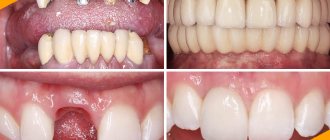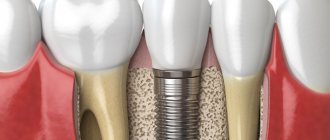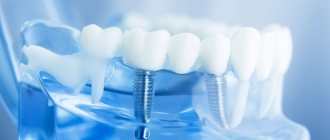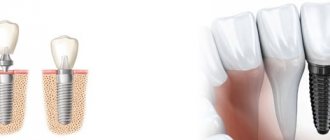The opinion that “implantation is painful” exists among those people who have not yet had such an operation. The fear has its roots in the Soviet past, when treatment and many procedures were indeed painful and were carried out without anesthesia. This approach has not been used for a long time. Modern high-quality dentistry offers treatment without pain; for this, specialists have a whole range of special methods and means. Therefore, there is no need to be afraid of implantation. This operation brings even less discomfort than tooth extraction or pulpitis treatment.
Dental implantation - does it hurt?
Is it painful or not to insert a dental implant? Many patients are interested. The answer is no, since the operation is performed under anesthesia. Types of anesthesia used in dentistry:
- Local - an injection is given, after which the sensitivity of the area disappears for the duration of the operation. The gums are “frozen”, and the bone tissues are not susceptible to pain.
- Anxiolysis is minimal sedation with a calming effect, the patient ceases to be afraid of the procedure.
- Moderate sedation - the patient is completely relaxed, but still conscious.
- Oversedation is a state of half-asleep.
- General anesthesia is rarely used. Indications: gag reflex, allergies to local anesthesia, mental disorders. Performed during extensive operations - bone grafting, installation of more than 10 implants.
In our Center, we offer the patient light sedation; the patient in this state does not feel pain, does not worry, and calmly responds to the doctor’s requests.
Preparing to install a dental crown
Preparing for a dental crown may include the following procedures:
- Professional teeth cleaning. Removing tartar and plaque from the surfaces of teeth will help you accurately select the color of the future crown, as well as identify primary caries and other diseases that are important to cure before placing a crown on the tooth.
- Treatment of caries, pulpitis, periodontitis, and gum inflammation. You can’t put a crown on sick teeth!
- Treatment of the tooth on which a crown will be placed. During this process, the doctor will drill out the tooth and remove all tissue affected by caries. If necessary, tooth depulpation is carried out, as well as treatment and filling of dental canals.
IMPORTANT: Dental canal treatment must be of high quality! If during the treatment of the canals the doctor makes a mistake, does not remove all the tissues affected by inflammation, or fills the canals incorrectly, the tooth may begin to hurt already under the crown, and then it will have to be removed and treated again! In our dental clinic “Firadent” in Moscow, treatment of tooth canals is carried out under a microscope with an optical device, which allows the doctor not to act at random, but to accurately see the length and internal space of the dental canals, and therefore carry out the procedure with impeccable quality.
After filling the canals, the tooth is restored with a filling and the next stage in prosthetics begins - turning the tooth under a crown.
How to install implants
Anesthesia is performed only during surgical interventions. Prosthetics is a painless procedure. The implantation process consists of several stages:
First surgical – implant installation
The procedure begins with anesthesia. The patient is injected with an anesthetic into the area where the artificial root is installed. If the operation is performed under sedation, the anesthesiologist will first administer a sedative intravenously. The gum is peeled off, and a bed for an artificial root is created in the bone using special instruments. The implant is inserted into the prepared hole, a plug is fixed on top, and the tissue is sutured. The operation lasts 15-30 minutes. The anesthesiologist brings the patient out of a half-asleep state, after 20-30 minutes the patient can move independently, even drive a car. The next appointment is scheduled in 10 days to remove the stitches. The implant takes 2-4 months to take root in the lower jaw and up to six months in the upper jaw.
The second surgical stage is the installation of a gum former
After engraftment with the jaw bone, the implant is opened, the plug is removed, and a former is inserted. The procedure is performed under local anesthesia and lasts no more than 10 minutes. The former is installed for 10-14 days to create an even gingival contour.
Prosthetics
This stage is completely painless, because... no tissue incisions are required. The former is replaced by an abutment that connects the implant and the prosthesis. A crown is installed on it, made from previously taken impressions.
When is it necessary to put a crown on a tooth: indications for restoring teeth with a crown
The need to place a crown on a tooth may arise in the following situations:
- The tooth is severely damaged by caries. If the natural crown of a tooth is damaged by more than 50% by caries, then it would be more correct to put a crown on the tooth rather than restore it with a filling. Large fillings do not withstand the chewing load well and may fall out or break, and the tooth may break along with the filling. If the root of the tooth is damaged, then it will have to be removed. By placing a crown on a decayed tooth, you have the opportunity to save it;
- The tooth is destroyed as a result of trauma. If the roots of a tooth were not affected by injury, it is possible to restore the tooth - it will be enough to put a crown on it;
- You can also put a crown on a tooth for aesthetic restoration: for example, if a tooth is chipped or its enamel has changed color, becoming gray or yellow, and this defect cannot be eliminated by classic whitening.
Doctors recommend placing temporary crowns to preserve teeth for patients with periodontitis. In this case, crowns prevent teeth from becoming loose and falling out.
In your case, do you need to put a crown on your tooth or is it possible to use another restoration method? The doctors of our dental clinic in Moscow, “Firadent,” can help you find the answer to this question. To make an appointment with our specialists, you just need to dial our dental clinic’s phone number!
The doctor’s opinion is that the operation itself is completely painless
Before installing a dental implant, patients often worry about the procedure and how they feel in the dentist’s chair. But there is no discomfort at all; the patient can only feel slight pressure or vibration. If we compare the procedure with tooth extraction, the latter feels much more unpleasant. For anxious patients, you can take a course of premedication before surgery.
Levin Dmitry Valerievich
Chief physician, Ph.D.
Initial examination and diagnosis
The decision that a crown needs to be placed on a tooth is made by an orthopedic dentist after examining the patient’s oral cavity and teeth, as well as performing a number of diagnostic measures. Based on the data obtained, the orthopedist will develop a treatment plan, which may include not only the installation procedure itself, but also a number of additional measures:
- Professional oral hygiene, which allows you to clean your teeth from plaque and tartar;
- Removal of severely damaged teeth that cannot be properly treated and restored with a filling;
- Treatment of caries and any other diseases of the teeth and gums diagnosed during examination;
- Tooth removal, treatment and filling of canals.
Note that depulping a tooth before placing a crown on it is not always done. The depulpation procedure involves removing the dental nerve, after which the tooth becomes more fragile and vulnerable to external factors. If a tooth has more than one root and is in good condition, doctors prefer not to remove the dental nerve and put a crown on a living tooth.
When drawing up a treatment plan, the question of what kind of crown will be placed on the tooth is also decided. Modern dental crowns are made from different materials and there is always the opportunity to choose the version of the prosthesis that will most suit the patient in terms of aesthetics, price and durability.
The drawn up treatment plan is agreed with the patient and after agreement the treatment process begins. The first step is to prepare the tooth for the installation of a crown.
How long does pain last after implantation?
Getting a dental implant does not hurt. But after the end of the anesthesia, discomfort will be felt; this is a normal reaction to the intervention. On average, it lasts 1-3 days, the intensity and duration depends on the volume of the operation and the number of artificial roots installed. The nature of the pain can be sharp, diffuse, shooting, pressing, aching or cutting. Other body reactions are within normal limits:
- itching;
- edema;
- compression of tissues and muscles.
MYTH 3: Implants often fail
Outdated disc and plate implant models caused many problems for patients due to complex, traumatic fixation into the bone. They did have a high rejection rate (50%). Such models have not been used for a long time, but the stereotypical opinion remains. The latest generation implantation systems are made from biocompatible, hypoallergenic material (medical titanium, zirconium oxide). Thanks to the root-shaped shape of the implant, similar to the anatomy of a natural tooth root, and a special active coating, successful engraftment is ensured in 98-99% of cases.
What to do to reduce pain
Unpleasant sensations come only after the anesthetic wears off. To reduce them it is recommended:
- take medications against pain, swelling, inflammation;
- avoid physical activity;
- do not touch the wound with your tongue or other objects;
- avoid hot baths, steam baths, saunas;
- do not drink alcohol, limit smoking.
We give out the necessary medications after the operation in a special package; you do not have to buy anything at the pharmacy. Rules for taking medications and other recommendations are indicated in the Patient Instruction.
Making crowns
Crowns are made from an impression that is taken from the prepared teeth. To obtain this impression, the orthodontist will use a special plastic mass. Based on the impression taken, the laboratory will first make a plaster model of the prosthesis, and then a crown, which will be placed on the tooth.
Modern dental crowns are made from different materials: metal, ceramic, metal-ceramic and zirconium. The timing of the production of the prosthesis will depend on what kind of crown it is decided to place on the tooth. Crowns made of ceramics and metal-ceramics take the longest to produce. So that a person does not have to walk without a tooth during the entire time of making the crowns, a temporary plastic prosthesis is put on the tooth.
IMPORTANT: Temporary plastic crowns help hide a defect in the dentition; a person will not have to be embarrassed by the absence of a tooth and experience stress for this reason. Also, temporary dentures help protect a ground and therefore weakened tooth from the negative effects of environmental factors and bacteria.
How long does it take for a wound to heal?
After surgery, the wound remains sensitive for 1-3 days. She needs special care for the next 2-3 weeks:
- upon returning home, apply ice or a cold compress to the intervention area;
- During the first hours you should not lie down, otherwise swelling may occur; it is better to sit or take a walk;
- You can only drink water at room temperature;
- Before the stitches are removed, you cannot eat flour, sticky foods, sweets, yoghurts; light soups, purees, and soft cutlets are allowed;
- in the first days, strong tea, coffee, and highly carbonated drinks are prohibited;
- You can chew only with the healthy side, rinse your mouth with warm water after each meal;
- one day after the operation, you can brush the adjacent teeth with a soft brush, but not with an electric brush or an irrigator.
If the pain in the implant area does not go away for a long time
Pain may be felt for up to 1-3 days, after which it is considered a deviation. Long-term discomfort is caused by impaired healing and microbial contamination. Signs of complications that do not stop for more than three days and are progressive:
- edema;
- bloody issues;
- strong pain;
- bad feeling;
- elevated temperature.
You cannot take anything on your own; you need to contact the doctor who performed the operation for help.
We want to reassure patients who are afraid to undergo implantation - this is a painless operation with a predictable successful result. Complex tooth extraction can be much more traumatic. If you follow the doctor's recommendations, there are no consequences. Even if all stages were successful, we schedule preventive examinations 2 times a year. This will help identify possible problems at an early stage and avoid complications.
Try-on, temporary and permanent fixation of the crown
Before placing a crown on a tooth, it must be tried on. For this purpose, the patient is invited to the clinic. During the fitting, the accuracy of the crown's manufacturing and the tightness of its fit on the stump base are assessed. If the fitting does not reveal manufacturing inaccuracies, the patient does not feel discomfort and is satisfied with the aesthetics of the finished product - a temporary fixation of the crown is performed on the tooth.
What is temporary fixation? This is a kind of “test drive” of the crown. With a crown placed on a temporary basis, the patient will walk for a certain period of time (usually up to 4 weeks). If during this time no defects or inaccuracies are identified in the manufacture of the crowns, the patient comes to the clinic and the crown is placed and fixed with permanent dental cement.
At this point, the crown installation process can be considered complete.










